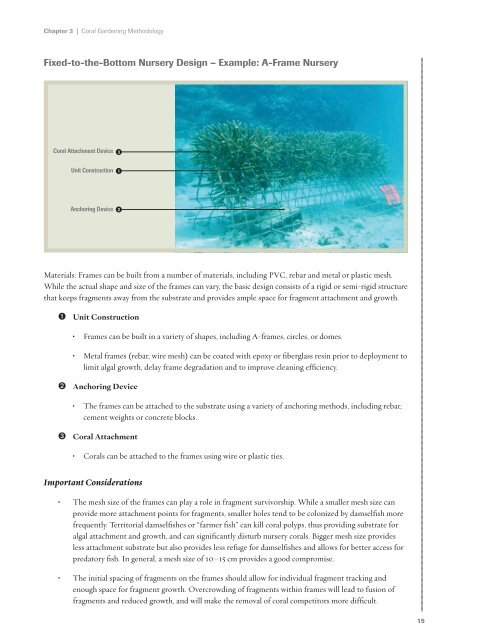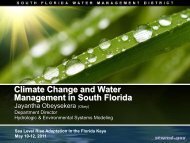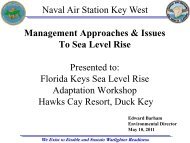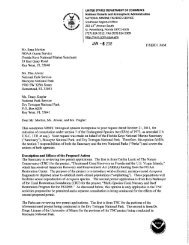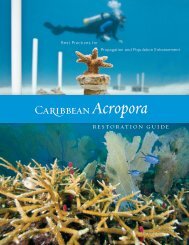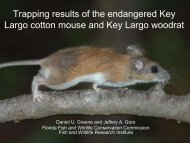Caribbean Acropora Restoration Guide - The Florida Reef ...
Caribbean Acropora Restoration Guide - The Florida Reef ...
Caribbean Acropora Restoration Guide - The Florida Reef ...
Create successful ePaper yourself
Turn your PDF publications into a flip-book with our unique Google optimized e-Paper software.
Chapter 3 | Coral Gardening Methodology<br />
Fixed-to-the-Bottom Nursery Design – Example: A-Frame Nursery<br />
Coral Attachment Device<br />
3<br />
Unit Construction<br />
1<br />
Anchoring Device 2<br />
Materials: Frames can be built from a number of materials, including PVC, rebar and metal or plastic mesh.<br />
While the actual shape and size of the frames can vary, the basic design consists of a rigid or semi-rigid structure<br />
that keeps fragments away from the substrate and provides ample space for fragment attachment and growth.<br />
➊ Unit Construction<br />
• Frames can be built in a variety of shapes, including A-frames, circles, or domes.<br />
• Metal frames (rebar, wire mesh) can be coated with epoxy or fiberglass resin prior to deployment to<br />
limit algal growth, delay frame degradation and to improve cleaning efficiency.<br />
➋ Anchoring Device<br />
• <strong>The</strong> frames can be attached to the substrate using a variety of anchoring methods, including rebar,<br />
cement weights or concrete blocks.<br />
➌ Coral Attachment<br />
• Corals can be attached to the frames using wire or plastic ties.<br />
Important Considerations<br />
• <strong>The</strong> mesh size of the frames can play a role in fragment survivorship. While a smaller mesh size can<br />
provide more attachment points for fragments, smaller holes tend to be colonized by damselfish more<br />
frequently. Territorial damselfishes or “farmer fish” can kill coral polyps, thus providing substrate for<br />
algal attachment and growth, and can significantly disturb nursery corals. Bigger mesh size provides<br />
less attachment substrate but also provides less refuge for damselfishes and allows for better access for<br />
predatory fish. In general, a mesh size of 10–15 cm provides a good compromise.<br />
• <strong>The</strong> initial spacing of fragments on the frames should allow for individual fragment tracking and<br />
enough space for fragment growth. Overcrowding of fragments within frames will lead to fusion of<br />
fragments and reduced growth, and will make the removal of coral competitors more difficult.<br />
15


